Great choice! Your favorites are temporarily saved for this session. Sign in to save them permanently, access them on any device, and receive relevant alerts.
- Sailboat Guide
Signet 20 is a 19 ′ 9 ″ / 6 m monohull sailboat designed by Ray Kaufmann and built by Hurley Marine Ltd. starting in 1960.


Rig and Sails
Auxilary power, accomodations, calculations.
The theoretical maximum speed that a displacement hull can move efficiently through the water is determined by it's waterline length and displacement. It may be unable to reach this speed if the boat is underpowered or heavily loaded, though it may exceed this speed given enough power. Read more.
Classic hull speed formula:
Hull Speed = 1.34 x √LWL
Max Speed/Length ratio = 8.26 ÷ Displacement/Length ratio .311 Hull Speed = Max Speed/Length ratio x √LWL
Sail Area / Displacement Ratio
A measure of the power of the sails relative to the weight of the boat. The higher the number, the higher the performance, but the harder the boat will be to handle. This ratio is a "non-dimensional" value that facilitates comparisons between boats of different types and sizes. Read more.
SA/D = SA ÷ (D ÷ 64) 2/3
- SA : Sail area in square feet, derived by adding the mainsail area to 100% of the foretriangle area (the lateral area above the deck between the mast and the forestay).
- D : Displacement in pounds.
Ballast / Displacement Ratio
A measure of the stability of a boat's hull that suggests how well a monohull will stand up to its sails. The ballast displacement ratio indicates how much of the weight of a boat is placed for maximum stability against capsizing and is an indicator of stiffness and resistance to capsize.
Ballast / Displacement * 100
Displacement / Length Ratio
A measure of the weight of the boat relative to it's length at the waterline. The higher a boat’s D/L ratio, the more easily it will carry a load and the more comfortable its motion will be. The lower a boat's ratio is, the less power it takes to drive the boat to its nominal hull speed or beyond. Read more.
D/L = (D ÷ 2240) ÷ (0.01 x LWL)³
- D: Displacement of the boat in pounds.
- LWL: Waterline length in feet
Comfort Ratio
This ratio assess how quickly and abruptly a boat’s hull reacts to waves in a significant seaway, these being the elements of a boat’s motion most likely to cause seasickness. Read more.
Comfort ratio = D ÷ (.65 x (.7 LWL + .3 LOA) x Beam 1.33 )
- D: Displacement of the boat in pounds
- LOA: Length overall in feet
- Beam: Width of boat at the widest point in feet
Capsize Screening Formula
This formula attempts to indicate whether a given boat might be too wide and light to readily right itself after being overturned in extreme conditions. Read more.
CSV = Beam ÷ ³√(D / 64)
THE SIGNET 20 was built both in the USA and the UK. A number of versions were produced: fixed or bilge keels, skeg or transom mounted rudders, etc/ Later UK models built by Gilmax Ltd became a Mark 2 version, known as a Signet Super 20. Inboard power was available as an option.
Embed this page on your own website by copying and pasting this code.
- About Sailboat Guide
©2024 Sea Time Tech, LLC
This site is protected by reCAPTCHA and the Google Privacy Policy and Terms of Service apply.
The Signet 20 was designed by American naval architect and yacht designer Ray Kaufman in around 1963. (Some books spell his name Roy Caufman). They were built in many countries around the world by various yards but mostly built in the US.The Signet was built by several yards in the UK but most were moulded by A.G. Hurley Marine Limited of Plymouth around 1965 to 1967 - also by Marineways Ltd and Sea Angling Charters of Abergavenny, Wales, plus Signet Marine Division. I.D. Baret & Co Ltd Monmouthshire, Wales. Standards of construction and finish varied significantly from builder to builder, as did interior layout. It is likely that Hurley Marine produced the mouldings and other yards completed and then sold the boats. The Signet 20 with Sail Number 15 was built by Hurley Marine and was used in all publicity shots for in literature for all other builders and completers.
George Hurley had one himself and raced it frequently in Plymouth Sound. It was his favourite boat apparently. Accommodation was usually open plan with two forward berths, galley with worktop amidships on either side of settee berths, which ran under the cockpit coamings.Some had a sea toilet between the forward V berths.
The Signet 20 is a strong and seaworthy little yacht similar in concept to the Hurley Felicity and Hurley 20.
Click here for the Yahoo Signet Owners' Group
Boat Profile
A trailer-sailer ideal for gunkholing
From Issue July 2023
I n late 2015, having left the demands of corporate work behind, I returned to sailing after an absence of 35-plus years as crew on an Elan 310 fractional sloop, racing as a member of the Royal Brighton Yacht Club on Port Phillip Bay in Victoria, Australia. I quickly started looking around for a suitable sailboat that I could use on non-racing days. To my dismay, I discovered that Australia, unlike the U.K., U.S., and many European countries, offered a paucity of viable craft. Many, if not most, of the available boats ranged from 30 to 50 years in age and, more often than not, required a major overhaul or a dignified burial.
Over the next three years, I took several wrong turns and traveled hours to view duds with more holes than the ridiculous number of zeros in the asking price. But at last, I narrowed my search and settled on looking for a trailerable sailboat. I also knew that it needed to be a boat I could sail on my own with minimal help, if needed, from my wife. In late 2019, I happened upon Bluewater’s Cygnet 20.
T he Cygnet 20 originated in 2013 with a brief by Bluewater Cruising Yachts’ founder, David Bradburn, presented to yacht designers Will Hardcastle and Peter Lowe, to create an entry-level cruising yacht at an affordable price, with overnight or weekend accommodation for a couple or family of four. In August 2017, the prototype was launched at the Sydney Boat Show.
The 23′ design was inspired by England’s small traditional gaff-rigged working boats. It evokes the past with its plumb stem and only slightly raked transom, fixed bowsprit, samson post, transom-hung rudder on bronze pintles and gudgeons, classic portholes, and of course, tanbark sails and high-peaked gaff. In just a few years, the Cygnet 20 has become a highly sought-after inland-waterways cruiser across Australia, suitable for both river raids and competition racing; one was even recently delivered to Lake George in upstate New York.
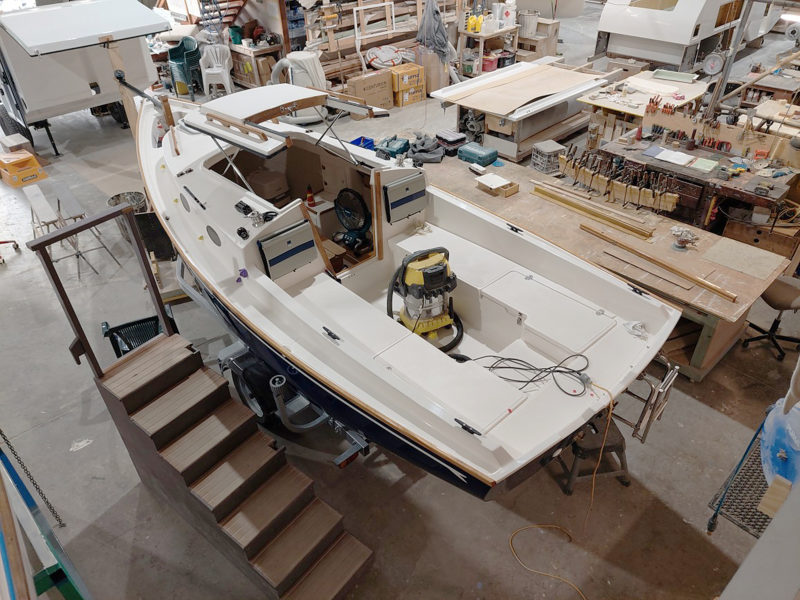
Still in the shop under construction, the lifting coach roof, with its simple expanding cross-struts, is clearly visible. This unusual feature increases headroom, ventilation, and natural light in the cabin.
The hull is built in two pieces. The first, a hand-laid, solid fiberglass molding, incorporates the hull and centerboard case. The second molding, also of hand-laid fiberglass, includes the deck, cabin, cockpit, water-ballast tanks, and interior structures including the berths. The two moldings are joined by an external hull flange at the gunwale, which is capped with a Pacific teak (Vitex) rubrail. Between the rubrail and the coach roof there is a narrow side deck, which provides a secure walkway along the entire length of the boat. The mast, gaff, boom, and bowsprit are carbon fiber and the sails are from Hood Sails in Sydney.
The mast is stepped in a deck-mounted stainless-steel tabernacle supported by a stainless-steel compression post mounted on the keel; it is held in place with a stainless-steel through-pin. The rudder is hung on bronze pintles and is easily removable. The foiled centerboard is of laminated fiberglass with 220 lbs of internal lead ballast. The bowsprit is mounted to the samson post, which acts as a secure mooring bitt.
All surfaces (hull, deck, coach roof, and interior) are offered in Oyster White as standard, but there is a wide range of hull-color options.
The rigging, and most of the deck hardware, is from Ronstan or Harken including jib tracks, jam cleats, mooring cleats, and standing-rigging fittings. The shrouds are U-bolted through the hull-and-deck joint, while the forestay is bolted to the end of the bowsprit, and the bobstay is U-bolted to the stem just above the boot top. Tufnell blocks and Langman cordage are fitted as standard and further complement the traditional look and feel of gaff-rigged boats.
Construction, including all rigging and interior outfitting, is by Bluewater Cruising Yachts who offer various optional items. For example, I chose to add four wooden Pacific teak (Vitex) handrails, a pop-top incorporated with the companionway hatch that includes a color-matched WeatherMAX UV fabric enclosure that features roll-up window covers, bug screens, and complete companionway zip-through access. It allows for full standing headroom below and increases the cabin’s natural light and ventilation.
While the Cygnet 20 is a production boat, that does not prevent the enthusiast from adding their own personal touches. I have added cabin instruments, including a barometer and clock, and a depthsounder, fitted a removable anchor roller, replaced the original sheet bags, and am working on wooden racks for a hand-held VHF, binoculars, and iPad.
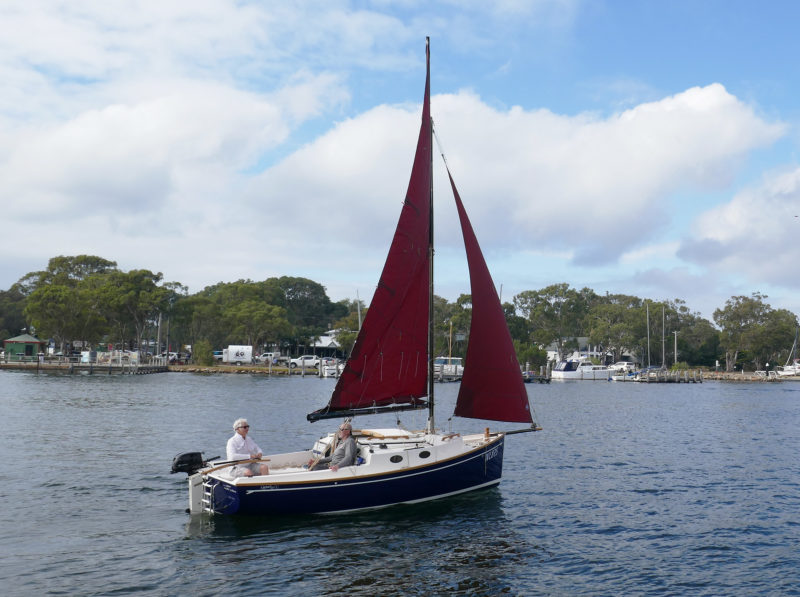
The spacious cockpit and high boom offer plenty of comfort for sailing with company, and with a tiller extension and running lines that all lead back to the cockpit, everything is easily to hand for the singlehanded sailor.
T he Cygnet 20 has a towing weight of 1,874 lbs. Loaded onto a single-axle trailer, offered by Bluewater, the Cygnet 20 can be towed by most family cars or an SUV.
When the Cygnet 20’s mast is lowered it pivots in the tabernacle, along with the boom, gaff, and both sails, which remain attached, and it is supported on a removable timber boom crutch at the stern. The rig is raised and lowered complete—the sails are bent on, the gaff and boom are attached to the mast, and the furled jib is left in place on the forestay. To rig the boat is straightforward, even for a singlehander: insert the two drain bungs, remove the trailer straps, remove and roll-up the one-piece sail cover, attach the Windex vane to the masthead, loosen all lines and remove any ties, and raise the mast while hauling in the forestay, which is led through a sheave at the end of the bowsprit then back to the cockpit. After the mast comes to a stop—fully upright in the tabernacle—the person doing the hauling walks forward to tie the forestay off at a bow-mounted cleat. Finally, a stainless-steel locking pin is inserted through the tabernacle and mast.
All that remains to be done is to raise the topping lift to free the boom crutch so it can be folded and put away, adjust the shroud tension (if necessary), tidy all lines, hang fenders, give one final check all around, and then launch the boat off the trailer. From start to finish, the boat can be rigged and launched within 30 minutes.
Thanks to the hull profile, the Cygnet 20 can stand upright when dried out. The forefoot is deep and flows into a wide, flat keel plank. With the engine, rudder, and centerboard raised you can run the boat up onto a sandy beach, drop the sand anchor, and camp overnight.
T he cockpit features two lazarettes, a deep coaming for good back support and a dry ride in a strong wind, and a nonskid surface throughout that offers surprisingly comfortable seating even without cushions. There is no mainsheet traveler; instead, the mainsheet is led through a 4:1 block-and-tackle system anchored in the center of the cockpit sole. As a result, the cockpit feels uncluttered and spacious and has ample seating for four adults. The starboard lazarette houses the fuel tank for the outboard motor as well as access for the fuel line. The port lazarette houses a hand-operated bilge pump, which is also used to empty the two internal water-ballast tanks, one located beneath (and across) the two quarter berths and the other tank beneath (and across) the cockpit sole aft of the centerboard. Each has a capacity of 63-1⁄2 U.S. gallons, and water is let in via a bronze through-hull and stainless-steel valves. The rear tank, subject to sailing conditions and preferences, can be isolated and not filled; filling the forward tank is a prerequisite before setting off. I found that on light wind days, with four adults on board, the Cygnet was well-balanced with only the forward ballast tank filled to capacity.
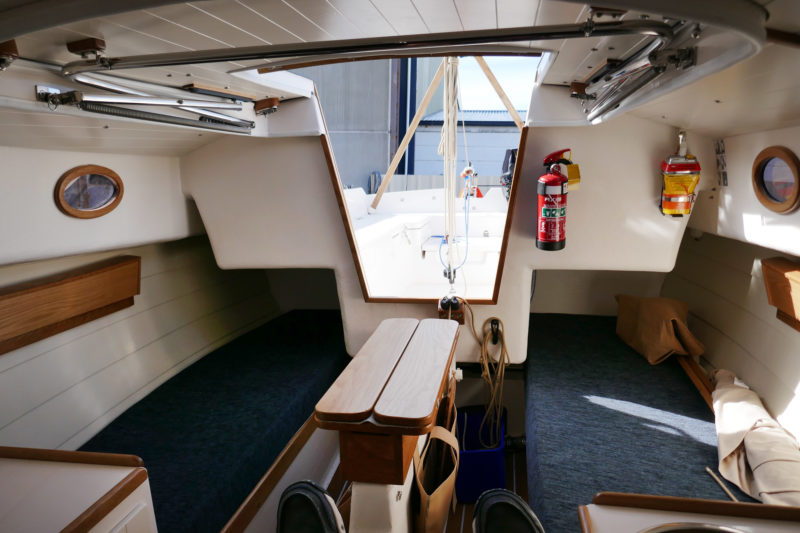
The two quarter berths are each more than 6′ in length making them suitable for taller crewmembers. The optional folding table sits above the centerboard trunk and provides a useful work surface even when folded away; when extended it is large enough for four people to dine in comfort.
Emptying the tanks requires about 100 strokes for the forward tank or about 150 strokes for both tanks. The system offers ballast flexibility: it can be adjusted according to conditions and crew numbers as well as used to reduce the weight for trailering. When filled, the ballast tanks add about 500 lbs to the overall weight.
D own below, the cabin has four berths. The two settee berths are 6′6″ long and ideal for those who are taller than 6′, while the V-berth in the bow is extremely comfortable for those under 6′. A porta-potti stows beneath the V-berth, while in the main cabin area there is a cupboard and sink to port and a cupboard with benchtop to starboard. An (optional) fold-out timber table, fitted over the centerboard case, provides adequate dining space for four. Lockers beneath all the berths—four under the settees and two under the V-berth—provide plenty of easily-accessed storage. The cabin sides and overhead are finished in V-grooved plywood, but other options are available. The companionway washboards are 7⁄16″ opaque acrylic and can be stowed in two purpose-made bags when not in use.
On my boat, auxiliary power is delivered by a Tohatsu 6-hp four-stroke long-shaft outboard mounted directly to the port side of the transom. (Previously a center motorwell for an inboard-outboard motor was offered, but this has been converted to a locker that can be used as an ice box—just add a bag of ice and your favorite drinks.) My motor can power the boat, with bare poles, up to 5 knots with minimal effort. A connecting arm from the outboard to a tiller provides positive control, in forward and reverse, and can be disengaged when sailing; it is part of Cygnet outfitting. The outboard can be raised out of the water when sailing to reduce drag. The tiller is Pacific teak (Vitex), and the fiberglass rudder blade can be pivoted up above the waterline for beaching and trailering.
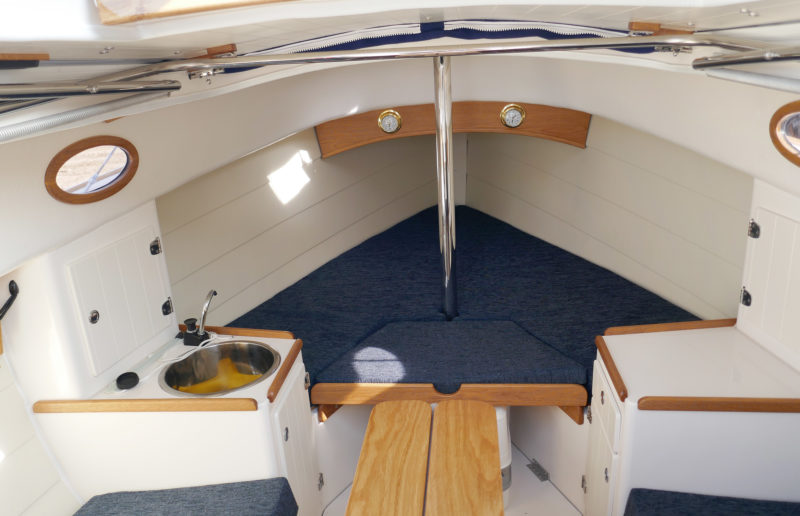
There is plenty of natural light throughout the cabin, thanks to the portlights, large companionway hatch and, when opened, the lifting coachroof. The forward V-berth conceals a porta-potti and lockers beneath its cushions.
U nder sail, movement around the cockpit is easy and the view forward is rarely obscured by the jib. The running lines, including jibsheets, all three halyards—jib, peak, and throat—and the topping lift are led back to jam cleats on the cabintop, within easy reach of the crew. I have added a Ronstan tiller extension so that I can also reach all the lines when helming, taking just one step forward to trim either sail while maintaining complete control of the rudder.
The Cygnet 20 provides a remarkably stable platform that tracks true and holds its course with a very light touch on the tiller. The pivoting centerboard, raised and lowered on a 10:1-ratio winch, allows the crew to bring the center of gravity aft in stronger winds by raising the board 25%, which in turn improves the windward heading. In approximately 10 knots of breeze, Navionics on the iPhone recorded our speed between 5.4 and 6.0 knots. The boat is exceptionally responsive to the helm and easily picks up speed after tacking. There’s no concern when jibing, as the helmsman can easily swing the main across with the mainsheet directly at hand.
The water ballast allows the boat’s center of gravity to be lowered, making the boat both more stable and more comfortable in stronger winds; the relatively short and light rig also contributes to this stability.
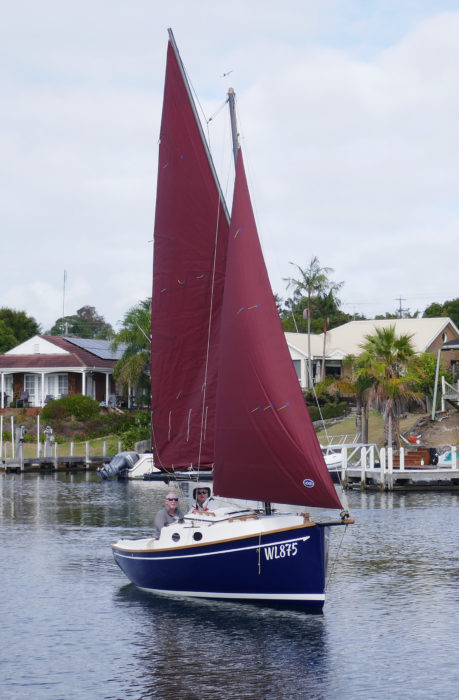
The plumb stem, short bowsprit, high-peaked gaff, tanbark sails, and traditional reefpoints clearly reflect the influence of late-19th and early-20th-century British working boats. Less obvious are the modern rigging details that allow one person to rig, launch, and set sail within 30 minutes.
The mainsail has two rows of reefpoints, and with the roller-furling jib there is a great deal of scope for shortening sail as the need arises. Additionally, the gaff-rigged mainsail can be scandalized: by lowering the peak, the sail is almost entirely depowered, and while this is not a good long-term solution for coping with heavy weather, it is a handy trick if you need to reduce sail area quickly and temporarily. A vang delivers control to the boom.
B eing designed for inland waterways, the Cygnet 20 does have (some) limitations (well, the only one that comes to mind is that I would not be keen to take it to sea, out of sight of land), but that does not preclude sailing in and around bays, coastal islands, and major rivers that open to the ocean. The versatility of the boat for inland sailing is hard to beat. The Cygnet can be fitted for rowing, complete with sliding seat on tracks set into the parallel cockpit benches, and carbon-fiber oars. When combined with the low height of the rig—just 19′ above the cabintop—and the ability to quickly lower the whole rig even when on the water, this rowing option allows the Cygnet 20 to explore many less accessible rivers and streams, even those crossed by fixed bridges.
I continue to enjoy the boat whatever the season, conditions, or locality, whether I’m cruising with my wife and friends, or just out for an enjoyable daysail on my own. At time of writing, I have booked the next sailing trip inter-state to Tasmania, taking full advantage of having a trailer-sailer that can be ferried overnight (approximately 245 nautical miles). Once in Tasmania, I will be faced with the difficult decision of choosing the first sailing destination from my wish list of about 50 lakes, rivers, bays, and coastal islands.
Jan Stephen Kent is the eldest of three children of Polish migrants who arrived in Australia in the early 1950s. Born and raised in Hobart, Tasmania, his love for the ocean came when he began surfing when he was 14 and has remained with him. He has surfed Peru, Portugal, South Africa, and most of Australia. He has five adult children and three grandchildren. He and his wife have traveled to Peru, Chile, Argentina, southern Africa countries, most of Europe and parts of Asia, and have sailed off Croatia and Sardinia. Set to retire late in 2023, he is still surfing, and messing around in boats has become his passion.
Cygnet Particulars
LOA/19′2-1⁄2″
LWL/17′8-1⁄2″
Beam/7′3-3⁄4″
Draft, centerboard up/ 1′1-1⁄2″
Draft, centerboard down/5′1-3⁄4″
Displacement (loaded)/2,756 lbs
Towing weight (not including trailer)/ 1,764 lbs
Jib/77 sq.ft
Mainsail/176.5 sq.ft
Fuel tank/3 gallons (US)
Fresh-water tank/5 gallons (US)
Required engine size/4hp
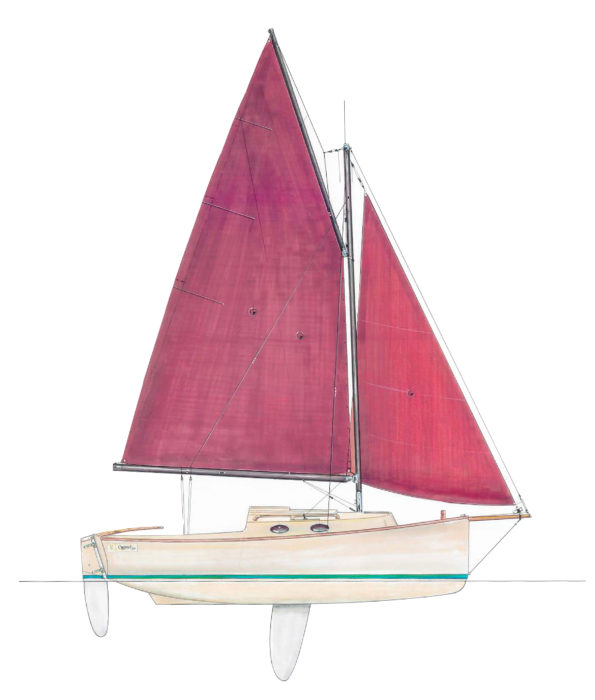
The Cygnet 20 is manufactured by Bluewater Cruising Yachts in Cardiff, New South Wales, Australia. The listed price is $72,600 AUS plus GST.
Is there a boat you’d like to know more about? Have you built one that you think Small Boats readers would enjoy? Please email us!
Share this article
Join The Conversation
We welcome your comments about this article. If you’d like to include a photo or a video with your comment, please email the file or link.
One thought on “ Cygnet 20 ”
I really like this design and the size is my favorite, easy to trailer and launch, and keep at home and visit many different places. I’m not a fan of the sliding Gunter mainsail rigging, and would consider changing that with recommendations from the designer.
Leave a Reply Cancel reply
Your email address will not be published. Required fields are marked *
Stay On Course
More From This Issue
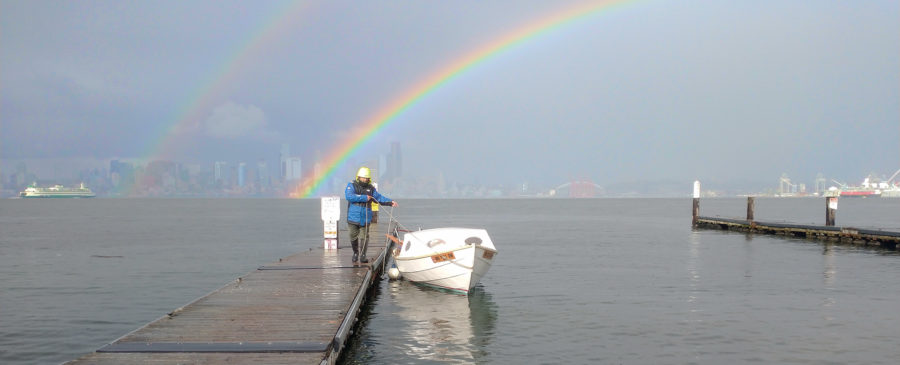
From The Editor
his past Father’s Day, my son Nate suggested we sail across Puget Sound to the village of Indianola for our annual outing. We had sailed there on a summer day...

The design was inspired by England’s small traditional gaff-rigged working boats. It evokes the past with its plumb stem and only slightly raked transom, fixed bowsprit, samson post, transom-hung rudder…
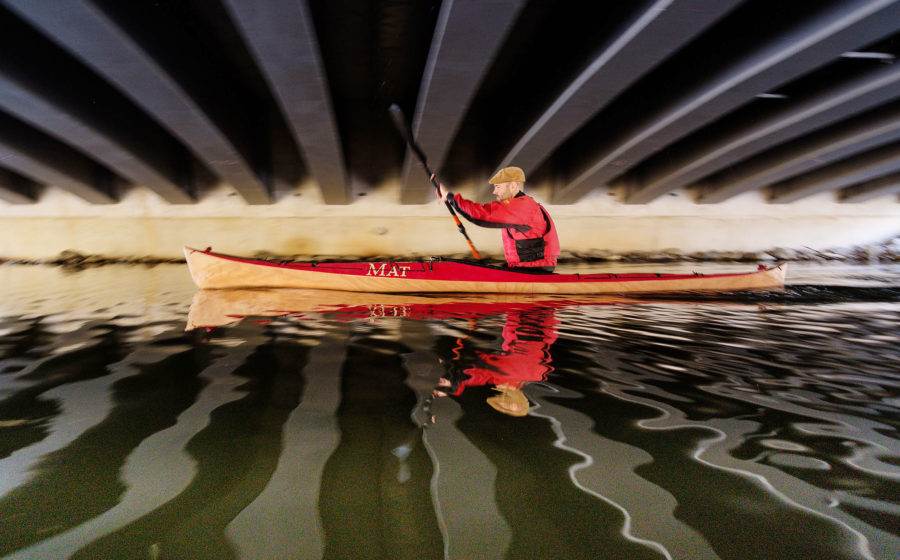
Petrel Play SG
I grew up as a whitewater paddler, and some years ago paddled a whitewater kayak to a little island in the Baltic Sea. The boat was quite capable in rough…
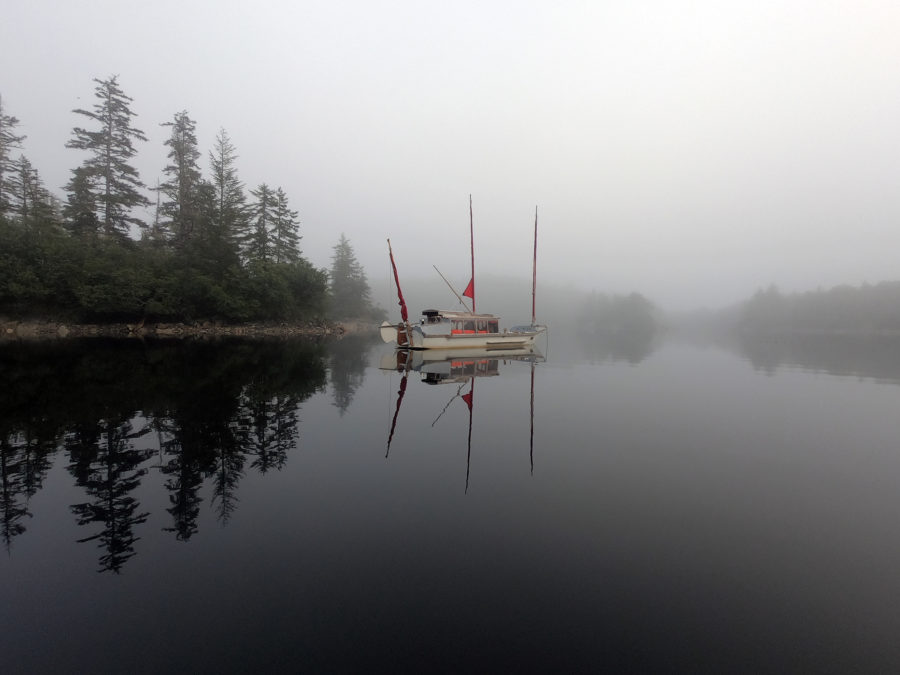
We had designed and built MUSTELID as a more easily driven adjunct to our larger, engineless liveaboard sailboat. As we have aged, sailing it has become more strenuous and we…
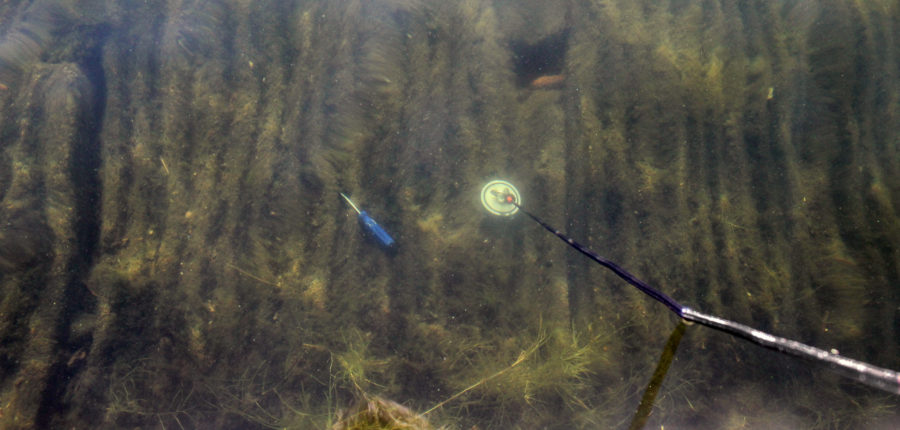
Magnet Retrieval
I was intrigued, for a while, by magnet fishing, but after seeing a lot of YouTube videos about it and watching a few magnet anglers at launch sites, I decided…
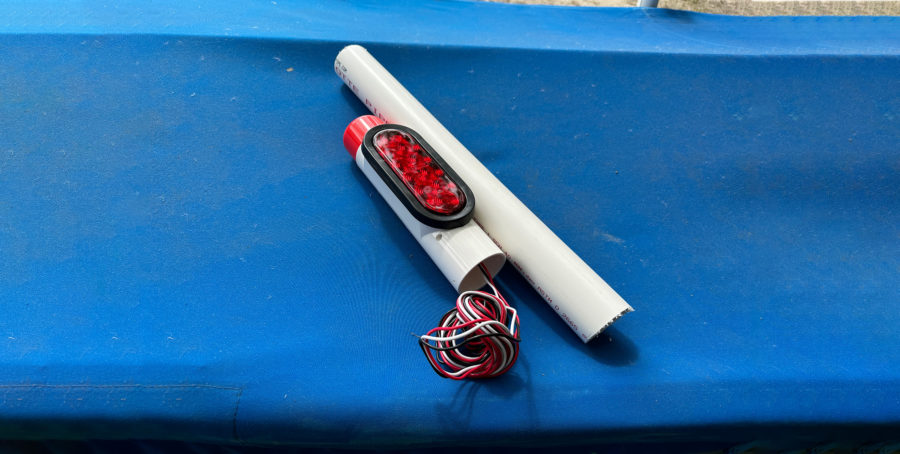
Product Reviews
Seavolt LED Tail Lights
We searched for trailer guidepost light kits and found an economical option, the SEAVOLT LED Trailer Guide-On kit. The kit consists of two LED light assemblies made from thick-walled PVC…
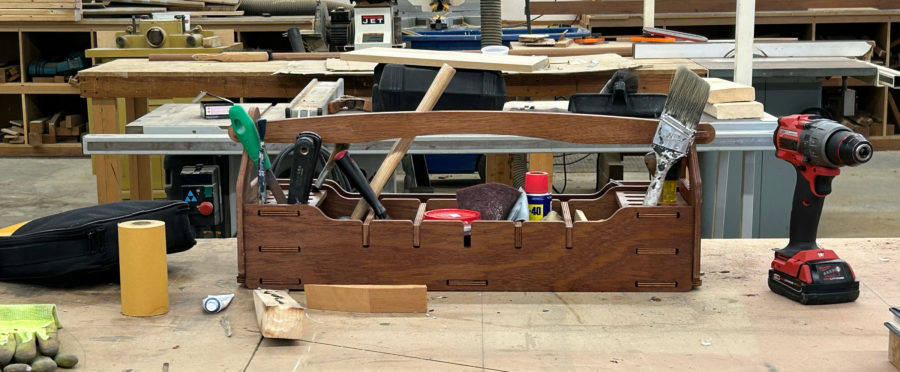
The CLC Tool Box Kit
After the shellac dried, all that was left to do was load up some tools. In each end, a shelf with holes can hold five screwdrivers and the two layers…
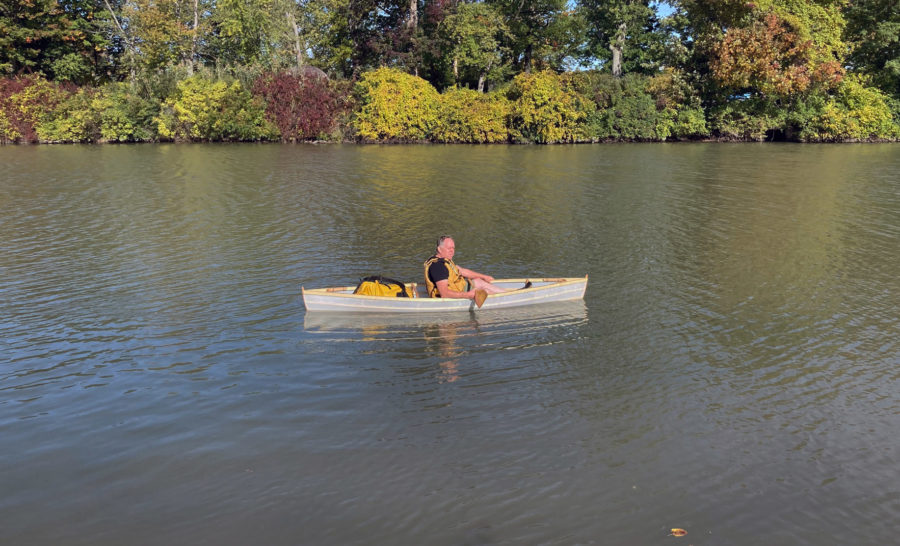
Reader Built Boats
Sharing a Sense of Freedom
John built his first boat, Percy Blandford’s PBK 26, a skin-on-frame kayak, when he was 16. He built two more for friends. Much later, in 1999, on leaving a career…
More Boat Profile
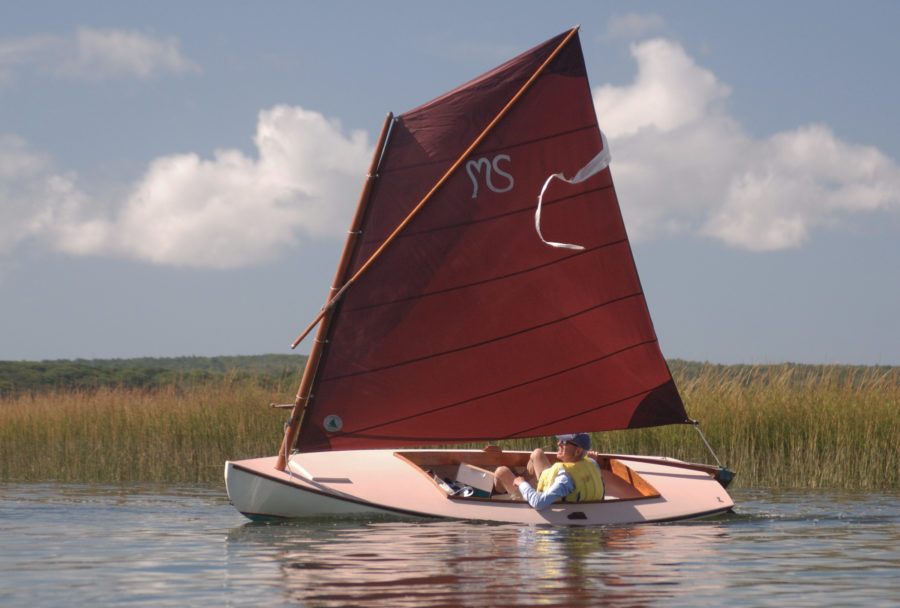
The Crawford Melonseed Skiff
The cockpit is a little over 6′ long—big enough for two people and a picnic. There’s room up under the deck for a cooler, anchor, and other gear, and a…
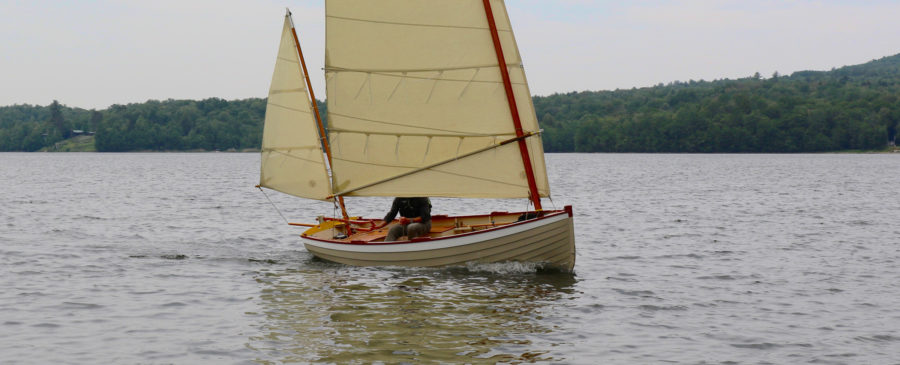
The Ilur arrives on pallets as a precut kit with CNC-cut components, including a strongback on which the hull is built. One of the key aspects of the kit-built method…
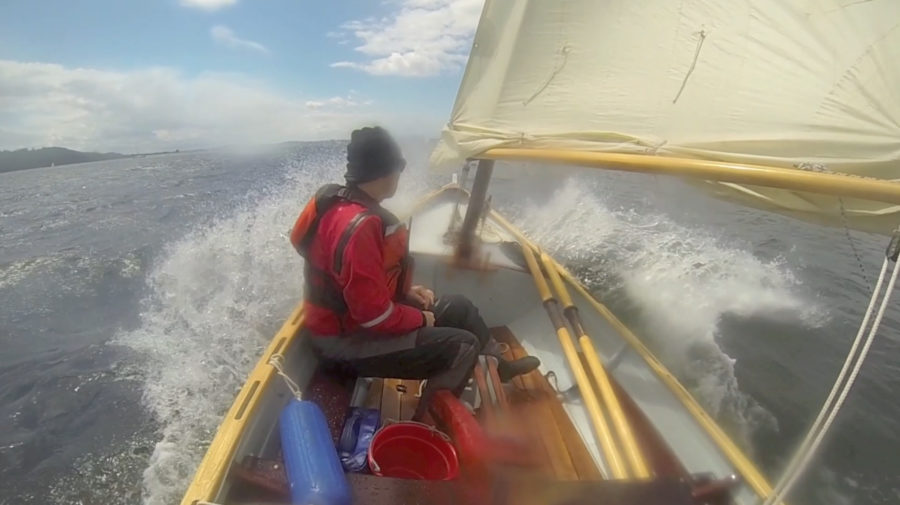
In 1982, when Eric Hvalsoe was fresh out of a two-year boatbuilding program at Bates Technical college in Tacoma, Washington, he launched the first Hvalsoe 13 (then named the Valso…
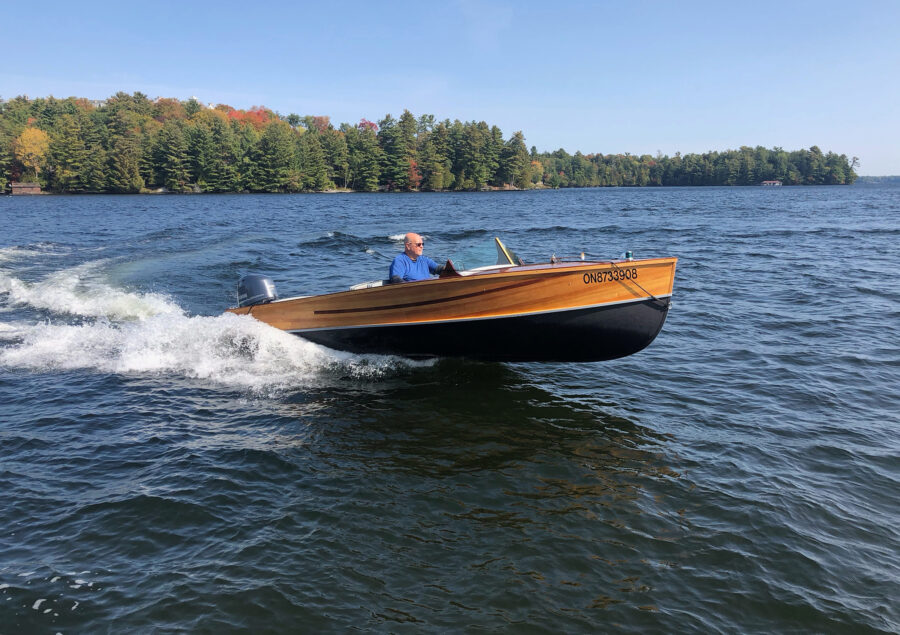
Georgian Bay
We ordered the Georgian Bay, an 18′ cedar-strip cruiser, which would include a 60-hp Yamaha high-thrust four-stroke outboard with electric trim. The base model of the boat, without any of…
Subscribe Today!
Become a subscriber today and you’ll recieve a new issue every month plus unlimited access to our full archive of backlogged issues.
Already a subscriber? Sign In
Subscribe For Full Access
Flipbooks are available to paid subscribers only. Subscribe now or log in for access.
The Signet 20 is a 19.83ft masthead sloop designed by Ray Kaufmann and built in fiberglass by Hurley Marine Ltd. since 1960.
The Signet 20 is a moderate weight sailboat which is a reasonably good performer. It is stable / stiff and has a low righting capability if capsized. It is best suited as a day-boat.
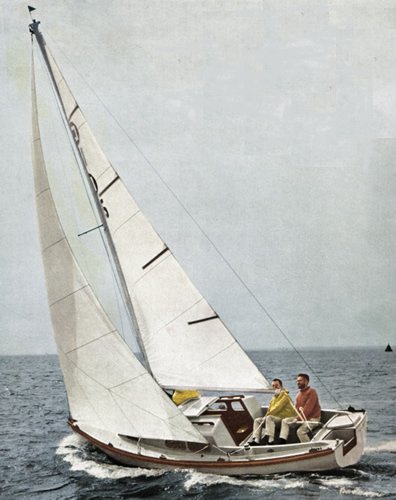
Signet 20 for sale elsewhere on the web:

Main features
Login or register to personnalize this screen.
You will be able to pin external links of your choice.

See how Sailboatlab works in video

We help you build your own hydraulic steering system - Lecomble & Schmitt
Accommodations
Builder data, other photos.
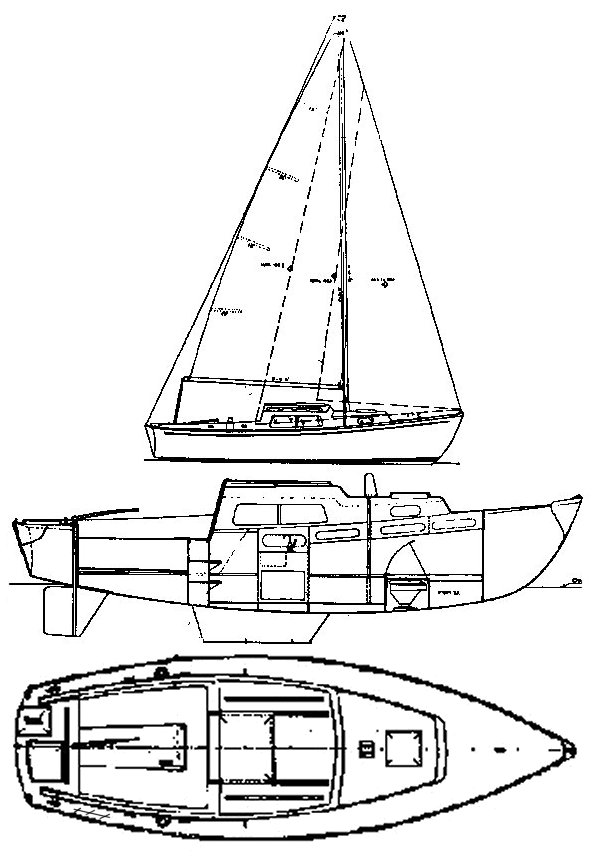
Modal Title
The content of your modal.
Personalize your sailboat data sheet

SIGNET 20 Specifications
Hull Type: Fin with rudder on skeg Rigging Type: Masthead Sloop LOA: 19.83 ft / 6.04 m LWL: 16.00 ft / 4.88 m S.A. (reported): 169.00 ft² / 15.70 m² Beam: 6.67 ft / 2.03 m Displacement: 2,146.00 lb / 973 kg Ballast: 800.00 lb / 363 kg Max Draft: 3.00 ft / 0.91 m Construction: FG Ballast Type: Lead First Built: 1960 Builder: Signet Marine, Ltd. Hurley Marine Ltd. Designer: Ray Kaufmann
Hull Speed: 5.36 kn
Related posts:
- GLASS SLIPPER 50
- HERRESHOFF 20
- NICHOLSON 36
- SHELTER ISLAND 33
Published by admin
View all posts by admin
Leave a Reply Cancel reply
Your email address will not be published. Required fields are marked *
Save my name, email, and website in this browser for the next time I comment.
SIGNET 20 Detailed Review
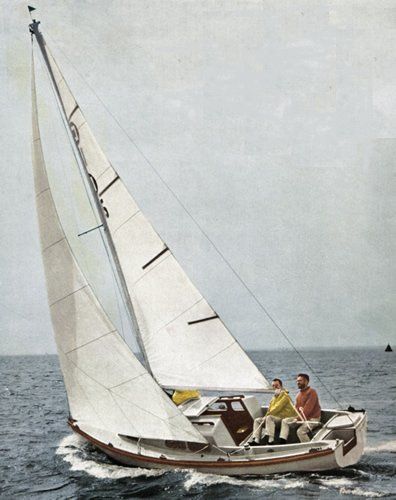
If you are a boat enthusiast looking to get more information on specs, built, make, etc. of different boats, then here is a complete review of SIGNET 20. Built by Hurley Marine Ltd. and designed by undefined, the boat was first built in 1960. It has a hull type of Fin with rudder on skeg and LOA is 6.04. Its sail area/displacement ratio 16.29. Its auxiliary power tank, manufactured by undefined, runs on undefined.
SIGNET 20 has retained its value as a result of superior building, a solid reputation, and a devoted owner base. Read on to find out more about SIGNET 20 and decide if it is a fit for your boating needs.
Boat Information
Boat specifications, sail boat calculation, rig and sail specs, contributions, who builds signet 20.
SIGNET 20 is built by Hurley Marine Ltd..
When was SIGNET 20 first built?
SIGNET 20 was first built in 1960.
How long is SIGNET 20?
SIGNET 20 is 4.88 m in length.

What is mast height on SIGNET 20?
SIGNET 20 has a mast height of 6.25 m.
Member Boats at HarborMoor

Cygnet 20 Trailer Yacht: Review
A beautiful handcrafted trailer yacht that promises plenty of adventure on the strength of the sea breeze.
It's a long time between drinks but the Cygnet 20 is a new craft that offers the same family-friendly qualities of the trailer-sailer that were so popular in the 1970s and 80s.
OVERVIEW - A fun day-sailer for hitting the road less-travelled The Aussie-made Cygnet offers a blend of comfortable day-sailer and overnight accommodation, yet also some retro charm via a bowsprit, curved sheer and gaff rig. However, don't be fooled by the cute appearance and timber trim. Under the skin, the Cygnet is really a contemporary sailboat with modern speed and performance.
All this makes the Cygnet a fun yacht to sail and just right for cruising our inshore coastal and inland waterways. Her compact size is made-to-measure for exploring all the interesting nooks and inlets close to shore.
Indeed, this trailer yacht is about the freedom to explore the places you just can't go with a deep keel yacht.
Her swing-up centreboard (keel), allows the Cygnet to safely navigate shallow bays and sandy shoals. If you hit bottom, simply raise the centreboard and sail off. Or you can nudge her up to the beach and go ashore. No need for a dinghy, of course!
First impression on Pittwater is of a sail craft ideally suited to sheltered waterway cruising. She would be perfect for coastal lakes like Lake Macquarie, or better still the Myall Lakes, which are too shallow for conventional yachts.
She is just the ticket to visit those beautiful, less travelled waters and find your own private beach-heaven.
The Cygnet's postcard-pretty lines are a joy to behold and only add pleasure to the sailing experience. To me, she evokes the character of those traditional English yachts with her red tan or traditional cream sails. Of course, the sails are made in modern Dacron.
Beneath the illusion of a traditional timber craft, you're really buying a modern fibreglass yacht. And that's fine if you're a wee bit jaded by the me-too look of modern yachts and yearn for something with the character and soul of timber yet not the maintenance.
Builder David Bradburn says the Cygnet 20 is also about providing more affordable yachting. And I agree that's something we sorely needed in the Australian yacht market at present.
Thanks to the Sydney design team of Hardcastle Lowe Yacht Design, the Cygnet 20 delivers a nice turn of speed under sail. The under-body is modern and her cut-off ends conform to the modern trend to maximise waterline length. The result is a craft that, in the right hands, will be a little terrier in twilight races.
The performance is enhanced in surprising ways. The gaff has been modernised with black carbon fibre spars to save weight. It makes rigging so much easier. The stubby mast sits in a hinged mast-step and the whole show, including boom, mainsail and gaff, folds flat when towing. A canvas travel cover goes over the lot when you finish sailing. And off you go.
PRICE AND EQUIPMENT - A trailer yacht tailored to your needs and budget The Cygnet 20 is being offered at a Standard Sailaway Specification and optioned to whatever level you require.
The Standard Sailaway version provides a ready-to-sail package with a set of white Dacron sails, water-ballast system, rigging, teak tiller, varnish timber gunwale capping, jib roller furler, and cabin with furniture moulding that provides four sleeping berths. The cabin has some timber trim and floor carpet and two aft bunk cushions. Price is $49,500.
The test boat Cygnet had all the creature comforts added like forward bunk cushions, Porta-Potti toilet, gas stove and folding dining table for four people. It also had a 4hp Tohatsu outboard, cabin pop-top, anchor with chain/warp, tan or cream sails. Price was $63,250 for this version.
A deluxe interior finish adds another $5,500 to the price and the trailer anther $4,400.
DECKS AND ACCOMMODATION - A family trailer yacht that sleeps and sails four or more Life aboard starts with the roomy, self-draining cockpit with seating room for 4-6 people with enough space to stretch out for a rest. It's a very comfortable cockpit to sail and relax, thanks to high backrests.
The outboard well is just under the tiller, so the motor is always ready to start at a moment's notice. Flanking the engine are spacious cockpit lockers so you can stow plenty of deck gear and stores.
Below is an inviting cabin with two quarter berths stretching aft and a double berth for'ard. In between the bunks, a fibreglass moulding provides a small galley with sink starboard, stove to port.
Up under the V-berth is the toilet. An optional curtain across the cabin will provide the necessary privacy for guests.
After sailing bigger boats, this cabin seems 'intimate' by comparison, yet it's actually very comfortable and has proper backrests. You can add an optional pop-top hatch which raises cabin headroom to 170cm.
HULL AND ENGINEERING - Water ballasted and well-made A key design feature of the Cygnet 20 is a water-ballast system that allows 230 litres of water ballast to be added when needed. This stability is added when sailing but towing weight remains low.
The folding centreboard also contributes a lot to stability when its locked down. It has 72kg of internal lead ballast.
The Cygnet features a one-piece fibreglass hull moulding with an ISO NPG gelcoat and high-density foam coring in the topsides and deck areas.
She certainly is a sturdy little ship with a solid fibreglass bottom with plenty of double-bias and biaxial layers of fibreglass. The internal fibreglass furniture moulding plus a 50mm stainless steel mast compression post adds further strength to the craft.
Unlike some of the early production trailer-sailers the Cygnet 20 is very easy on the eye. The compact trunk cabin looks just right and nicely finished off with a pair of oval-shaped window ports.
ON THE WATER - A gaff rig and a slippery hull Under sail in a moderate breeze of 6-10 knots, the Cygnet quickly revealed her performance.
Her long waterline and moderate hull volume glided easily through the water and left an incredibly clean wake. The racing pedigree was also evident in the way she heeled to the gust yet the helm pressure did not load up.
As I steered her upwind, the Cygnet quickly slipped into the groove, and picked up speed promptly after each tack. The long waterline and deep, hydrodynamic shaped centreboard allowed her to slip along nicely at around five knots in only 6-10 knots of breeze.
The Cygnet 20 is a very responsive boat and the way she points high to wind confirms a sailing efficiency more akin to a modern yacht. On a more practical level, she is very easy to sail single-handed thanks to the jib sheets running to cabin-top jammers, easily reached from the helm.
The central mainsheet also falls easy to hand and you can adjust the centreboard from the cockpit with a 6:1 drum winch.
Admittedly, the gaff rig has the added complication of twin halyards, however, it's surprising how quickly you become familiar with the controls.
In strong winds, you would certainly need to take a reef in the big mainsail. However, a clever trick you could employ when caught by a sudden squall is to dip the gaff. This way you de-power the sail without losing helm balance or speed.
By the way, that big 'fat' gaff-mainsail pushes her along surprisingly fast downwind. Later in the day the boys had her doing 7.5 knots when the breeze pipping in at 20 knots.
VERDICT - An affordable family trailer yacht with charm The Cygnet is something we need in the market — an affordable, compact, yet comfortable yacht for inshore sailing. She is also fast enough to shine in club races yet not too extreme to handle. And she sleeps a family.
Most importantly, the Cygnet provides a big, safe cockpit with all sail controls, plus motor, within reach of the helm.
On road weight of around 1100kg places the Cygnet within the tow capacity of popular mid-sized cars like the Camry or SUV Subaru Forrester. And if there's no room to park her at home then a marina dry-store facility would be your answer.
LIKES >> Easy, one-step rigging >> Very suitable for trailing >> Just so pretty to look at
NOT SO MUCH >> Lack of extra purchase or winch for jib >> Needs a swim step on transom >> Some water drag from outboard well
Specifications: Cygnet 20 Trailer Yacht Price as Tested: $63,250 for test boat with all the creature comforts including forward bunk cushions, Porta-Potti toilet, gas stove and folding dining table for four people, 4hp Tohatsu outboard, cabin pop-top, anchor with chain/warp, tan or cream sails. A deluxe interior finish adds another $5500 to the price and the trailer anther $4400. Price From: $49,500 for Standard Sailaway version as a ready-to-sail package with a set of white Dacron sails, water-ballast system, rigging, teak tiller, varnish timber gunwale capping, jib roller furler, and cabin with furniture moulding that provides four sleeping berths. The cabin has some timber trim and floor carpet and two aft bunk cushions.
LOA: 5.85m LWL: 5.4m Beam: 2.23m Draft: 0.34m - 1.57m Dry Boat Weight: 800kg Trailing Weight: 1100kg Loaded Displacement: 1250kg Working Sail Area: 23.5sq m Fuel tankage: 12lt Fresh water: 20lt Auxiliary: 4hp outboard
Supplied and built by: Bluewater Cruising Yachts Cardiff, NSW, 2285 Phone: 02 4956 8522 See Bluewater Cruising Yachts.
Stay up to date
Become a boatsales member and get the latest news, reviews and advice straight to your inbox.
The Cygnet 20 has been designed to be light to tow, fast to sail, quick to setup mast and able to be rowed making her a unique craft as well being able to accommodate 4 adults.
EXPLORE - ADVENTURE - RAID
Cygnet 20 #16 adventures on ?uccellino? with phil & jodi rose – youtube.
Trailer Sailor Uccellino sails on Lake Argyle in Western Australia, July 2022
Cygnet 20 Trailer Yacht. 1 Minute Rig Setup ... Easiest Trailer Sailer! – YouTube
Hawkesbury River Raid. Sailing and rowing the Cygnet 20. – YouTube
Sailing the Cygnet 20. – YouTube
Cygnet 20. Fast and easy setup and launch. Here's how! � YouTube
Cygnet 20 sailing to victory in strong wind! - YouTube
Sailing the Bluewater Cygnet 20. Long edit. - YouTube
There’s so much to love about the New Cygnet 20!
It’s versatile.
Discover the sheer joy of sailing again – or – for the first time! The easy, safe and forgiving Cygnet 20 is equally perfect for the weekend family sailor or the experienced sailor looking for hands on action once again. This light and fast modern gaffer is an ideal inshore cruiser or club racer.
The Cygnet 20 can be put on a trailer and towed behind the family car giving you freedom to explore inshore bays, pull up to beaches or enjoy quiet anchorages with family or friends. The lifting keel is operated from the cockpit meaning it’s simple to arrive in shallow bays or near the beach.
The rigging is quick and easily done on the trailer or in the water. Water ballast, pumped in or out through the large capacity bilge pump, ensures safety and performance while sailing. Off the water it’s light to tow, launch and recover when un-ballasted.
It’s Seaworthy and Quick!
The Cygnet 20 has a sail wardrobe of high peaked gaff mainsail plus roller furling jib and features a deck stepped rig with light easily handled carbon fibre spars. The modern design hull will deliver good performance under sail or motor.
All sheets lead back to the cockpit ensuring safe and quick handling in most sea conditions. The recommended 4HP outboard motor fits neatly in the self-draining motor well and is easily stowed for maximum sailing performance.
It’s Comfortable!
The Cygnet 20 has a generous cockpit for excellent day sailing combined with weekend accommodation below for a couple or a family of 4. The cabin is cosy with a pop-up top for headroom when anchored, a double forward V-berth and an on-board porta potti. In the galley, you’ll find a single burner butane stove, a cupboard for dinnerware, cutlery drawer, storage and sink.
It’s a Trailer Boat you will be Proud to Own!
Designed and built in Australia with the appealing lines and unmistakeable character of a traditional gaffer, the Cygnet 20 is truly a modern adaptation of a classic beauty. From the carbon fibre bowsprit with headsail roller furler to the vintage shape of the hull and deck the Cygnet 20 will stand out from the other small yachts on the water. The hull and deck are classic white GRP with varnished tiller and gunwale.
It’s Affordable!
The Cygnet 20 is a perfect boat to begin a lifetime of sailing enjoyment. If getting out on the water has always been a dream put off until the endless “tomorrow” this is the boat to make that dream a reality. There’s nothing like the fun of learning new skills and introducing the family to the fun of sailing.
With a price comparable to a mid-size 4-wheel drive the Cygnet is the attractive yacht you can afford and enjoy today. And, just like the larger yachts in the Bluewater family, you can expect the Cygnet 20 to retain its appeal and resale value for years to come.
- TOPSAIL MARINE YACHT BROKERS
- +44 (0)7977 923952 | info@topsail.co.uk
- Yachts & Boats For Sale | Sell Your Boat | Marine Insurance | Links | Blog
ARCHIVE LISTING - NOT FOR SALE!
ARCHIVE LISTINGS ARE PROVIDED FOR INFORMATION AND RESEARCH PURPOSES ONLY.
1969 Signet 20 - £350
Status : NOT FOR SALE
Lying : Norfolk Broads - Viewing strictly by appointment through Topsail

General Specification
LOA : 6.05m (19ft 10in) LWL : 4.88m (16ft 0in) Beam : 2.03m (6ft 8in) Draft : 0.61m (2ft 0in) Displacement : 975kg Ballast : 364kg Keel : Bilge/Twin
Construction
- GRP construction
- Designed by Ray Kaufman
Rigging & Sails
- Bermudan Sloop
- Alloy mast/spars
- Tabernacle and pole (modified spinnaker pole) for mast lowering
- Recent stainless standing rigging
- Recent mainsheet & topping lift
- 2 x winches
- Large slab reefing main
- Plastimo furling headsail gear (not fitted)
- Spinnaker (no pole or ropes)
Mechanical & Electrical
Accommodation.
- 4 berths in 1 cabin
- V-berth plus 2 x single quarter berths
- PVC berth cushions
- Chemical toilet (under v-berth)
- Portable camping-style single gas burner
- Cabin table
- Cabin lights
- Ample storage space throughout
- Headroom 1.24m (4ft 1in)
- Autohelm tiller pilot approximately 2 years old (not fitted)
- Seafarer echo sounder with transducer (not fitted)
- 2 x anchors & anchor chain
The Signet 20 is a strong and seaworthy little yacht, and her shallow draft makes her ideal for cruising the Broads and East Coast. This example is being sold 'as seen' as a project boat, and without a trailer or engine. She needs repainting inside and out, new upholstery, and some small repairs (for example, replacement sections of toerail and a replacement jib sheet track). Currently lying ashore.
Please note: Offers will not be considered.
DISCLAIMER: Topsail Marine Yacht Brokers is acting as brokers (or in the case of classified adverts, advertising medium) only and unless stated otherwise the vendor is not selling in the course of business. Whilst every care has been taken in their preparation, the correctness of particulars is not guaranteed and they are intended as a guide only. Prospective purchasers are strongly advised to check all particulars and where appropriate employ an independent qualified agent to carry out a survey and/or sea/river trial. Vessels are offered subject to prior sale, amendment or withdrawal without notice.
You are welcome to link to this page, but please do not use content in any other way without our permission.
1553 Sea Mist 08111104
- Sitemap | About Us | RSS
- © 1990-2024 Topsail Marine Yacht Brokers, Norwich, UK. All rights reserved. Privacy Notice: This website does not use cookies or collect, store or process any personal data. Website hosted by Stablepoint. W3C | W3C
See Rough Water "Running for Deception Pass"
Home > Find Your Sail > Search by Make and Model > Signet > Signet 20
" * " indicates required fields
Step 1 of 3
Let's Get to Know Each Other
Let's connect, why it's important to partner with a designer on your signet 20 sail.
The design is the most critical part of your new sail. Ensuring the sail fits and performs its best is a must for our crew. The Precision Sails Design team are experts at their craft. Unlike other sail lofts all of our sailors work one-on-one with a designer to perfect their Signet 20 sail.
No Two Signet 20 Sails Are Alike
There are many factors that affect the performance and design of your sails. Location, sailing experience, and weather conditions all come into play when picking the perfect sail. Two mainsails made for two Signet 20’s in California and Florida will have different designs, sailcloth, and options based on what is best for the sailor.
Taking measurements is easy. All sailors work alongside our measurement team to measure and confirm their rig specs. This helps ensure your design is flawless and allows us to extend our Perfect Fit Guarantee to all of our sailors.
Discover the best cloth for your sailing needs, our sail details, or more about how Precision Sails is leading the sail-making industry with innovative new practices.
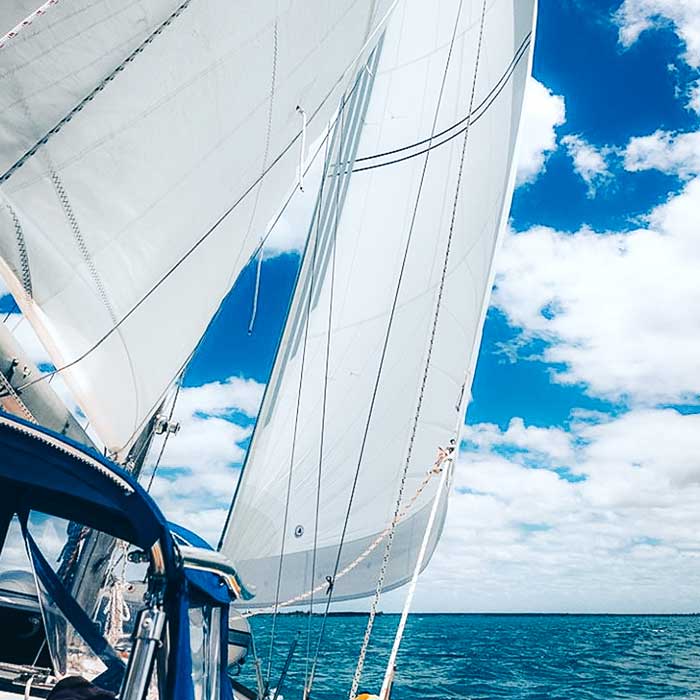
Proudly offering the largest selection of sailcloth in the industry, our team is always available to help you find your perfect sail. Whether you're a weekend sailor, coastal cruiser, or club racer our team is ready to walk you through the process.
Types of Sails
Precision Sail Loft specializes in producing headsails, mainsails, spinnakers, gennakers, and code zeros. So no matter the type of sail you’re looking for, we can help. Our sails are trusted by cruisers and racers alike from around the globe. Review the sail options and craftsmanship available to customize your dream sail.
Build & Process
Every sail we craft is produced to the highest standards with the best hardware, craftsmanship, and skill-set in the industry. Pair that with Precision Sails' approach to communication and your sailboat will be ready to set sail before you know it.
Unparalleled Commitment To Helping Sailors
As experts in design, communication, and production our team is ready to take on the task of making sails for your boat. Give us a call to get started.
“ I just received my asymmetrical spinnaker, with sock and turtle bag, along with a new 135 Genoa. The entire process was simple and both sales and the design team were in regular contact if there were any questions. The customer portal was easy to use and lets you keep track of where in the process your sails are. Great sails, great service -Graham Edwards (Facebook)
“ The whole team at Precision Sails was fantastic from start to finish. We’ve had a laminate main and genoa made so far and have a spinnaker on the way. They listened carefully to our needs and recommended a great sail cloth. We couldn’t have gotten more bang for our buck! -Noah Regelous (Google)
“ We received our spinnaker and launched it yesterday and I just wanted to let you know how pleased we are with it. The service we received from your company was exceptional and the quality of your product is second to none. We will certainly be return customers in the next few months to replace our main and jib sails and will recommend your company to all our sailing buddies. Once again-thank you.” -Daniel Jackson (Google)
“ we had good communication during the planning stages and the knowledgeable people at precision sails really got me fixed up good! The sails look and work fabulous! my boat sails better than it ever had! couldn’t be more pleased with the product AND the service!” -Fred Jelich (Facebook)
“ Our new furling jib for a Corsair 27 Had to be specially designed due to the height of the furler, but this was accomplished quickly and in short order we had our sail which fits beautifully and has a great shape. It’s everything we could have wanted, high tech design, thoughtfully executed and affordable.” -Nancy Y. (Yelp)
Request a Signet 20 Quote
Looking to buy a new headsail or mainsail for your Signet 20? Request a free quote from Precision Sails for a new custom sail. Our team will work with you to design the perfect sail for you.
Thanks for telling us a bit about yourself and your boat. Our team will send you a preliminary quote based on information we have gathered from sailors similar to you.
We will give you a call in order to narrow down the options on your quote and improve the accuracy. If you want us to call you at a specific time, feel free to schedule a time on our calendar!
Thanks for telling us a bit about yourself and your boat. Our team will reach out to offer some suggestions and get started on finding you the perfect sail!
The 5 stages of the 2024 total solar eclipse explained for April 8
On Monday (April 8), a total solar eclipse will sweep across the Americas. Here's how it will play out.

Stage 1: First contact
Stage 2: second contact, stage 3: totality, stage 4: third contact, stage 5: fourth contact.
On Monday, April 8, the 2024 total solar eclipse will sweep through the sky over North America.
While all of North America and Central America will experience at least a partial solar eclipse , those within a path with a width of approximately 115 miles (185 kilometers) passing over 15 U.S. States. Mexico, and Canada will also witness a totality as the moon entirely covers the disk of the sun.
You can watch the total solar eclipse live on Space.com . You can also keep up with all the eclipse-related action with our total solar eclipse 2024 live updates blog.
Don't be in the dark about the 2024 total eclipse
There are three major types of solar eclipse. A total solar eclipse like that on April 8 occurs when the moon is relatively close to Earth and blocks the entire disk of the sun.
Because the moon's orbit around our planet is an ellipse, sometimes it is further away and thus appears smaller. An eclipse at these times sees the moon only an obscure part of the solar disk, with the sun appearing as a glowing ring of fire. These events are called annular solar eclipses , and the last one seen over the U.S. occurred on Oct. 14, 2023.
Finally, a partial solar eclipse is an event that happens when the Earth, moon, and sun are not perfectly aligned, resulting in the lunar disk only covering part of our star, making the sun appear as if a bite has been taken out of it. Partial eclipses also happen at the beginning and ending stages of total and annular eclipses.
On April 8, 2024, the moon will be in its new moon phase , and it will look relatively large, meaning it is capable of covering 100% of the sun's disk as viewed from the narrow path of totality. The fraction of the diameter of the sun covered by the moon is known as the magnitude of a solar eclipse . On April 8, 2024, this value will be 1.0566, according to EclipseWise.com , slightly more than total coverage.
Get the Space.com Newsletter
Breaking space news, the latest updates on rocket launches, skywatching events and more!
NASA has released an interactive map of the total eclipse, which space enthusiasts can use to track the totality as it drifts across the globe. However, location won't be the only factor affecting the appearance of the total solar eclipse on Monday. The eclipse will pass through 5 distinct stages, with each of these phases occurring at different times across different locations.
What are the stages of the annular solar eclipse?
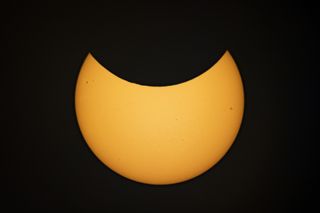
In the initial stage of the eclipse, the moon will begin to pass in front of the sun, kick-starting a partial solar eclipse. During this phase, the darkened lunar disk of the moon will make the sun appear as if a bite has been taken out of its illuminated face. This "bite" will get bigger and bigger as the totality approaches.
During the first stage of the total solar eclipse, some onlookers will be able to see rapidly moving, long, dark bands called " shadow bands " on the sides of buildings or the ground. Bailey's beads , caused by light streaming through the valleys on the horizon of the moon, may also be visible at the moon's edges during this initial stage. These phenomena repeat during the second partial eclipse that occurs after totality.
On April 8, this stage of the partial eclipse will first be seen near Pu‘uali‘i, Hawaii, at 6:27 a.m. local time (12:27 p.m. EDT, 1627 GMT).

First contact will last for between 70 and 80 minutes, and its conclusion will be marked by a single bright spot, or " diamond ring ," appearing at the edge of the moon. This marks the second contact stage and heralds the oncoming totality.
On April 8, the total solar eclipse will make landfall at Mazatlán, Sinaloa, Mexico, at 9:51 a.m. local time (12:51 p.m. EDT, 16:51 GMT).

Stage 3 and the mid-point of the total solar eclipse is the totality. At this point, the moon completely covers the solar disk. During the totality of the outer atmosphere of the sun, the corona may become visible as white streamers at the edge of the moon. This region is usually washed out by bright light from the solar surface, the photosphere. The inner atmosphere of the sun, the chromosphere , may be visible as a wispy aura around the edge of the moon.
The totality may also make stars and planets visible in the darkened sky that are usually not visible from America during daylight hours.
On April 8, the first location to experience totality will be Mazatlán, Sinaloa, Mexico at 11:07 a.m. local time (2:07 p.m. EDT, 1807 GMT). The first location to experience totality in the U.S. will be Near Florentino Ramos Colonia, Texas, at 1:27 p.m. local time (2:27 p.m. EDT, 1827 GMT).
The duration of the totality depends on the path from which the eclipse is viewed. In Mexico, totality will last for 40 minutes and 43 seconds. Skywatchers in the U.S. will collectively experience totality for 67 minutes and 58 seconds. Onlookers in Canada will experience the totality of the solar eclipse for 34 minutes and 4 seconds.

The fourth stage of the total solar eclipse, third contact, will see the moon start to move away from the disk of the sun, thus ending the totality and starting the second partial eclipse period. Brightening appears on the opposite side of the moon as it did during the second contact period. At this time, skywatchers will get another chance to spot Baily's Beads along the edge of the moon and shadow bands on the buildings and ground around them, with this stage mirroring the second contact stage.
The total solar eclipse ends on the Atlantic coast at 5:16 p.m. local time (3:46 p.m. EDT, 1946 GMT).
The fifth and final stage of the total solar eclipse. The moon moves away from the disk of the sun, meaning that at fourth contact, the moon is no longer even partially eclipsing the sun. At this point, 2024's total solar eclipse will be over.
On April 8, on the Atlantic coast of Newfoundland and Labrador, the partial eclipse phase ends at 6:18 p.m. local time (4:48 p.m. EDT, 2048 GMT).
— A 'horned' comet may be visible during the 2024 total solar eclipse
— How photos of the April 8 solar eclipse will help us understand of the sun's atmosphere
— How fast will April's total solar eclipse travel?
If you intend to view any of these stages, the most important thing to consider is how to safely view it. Looking at the sun without adequate protection at any time is harmful to the eyes, so eclipse watchers should take precautions on Monday.
Sunglasses, regardless of how dark they are, can't protect the eyes from the effect of the sun, so specialized eclipse glasses made from safe solar filter materials will be needed. If skywatchers intend to watch the event with a telescope, special filters will be needed to make this a safe viewing experience.
Our how to observe the sun safely guide tells you everything you need to know about safe solar observations.
Following the 2024 total solar eclipse, skywatchers in the U.S. will next get the opportunity to see a total solar eclipse on March 30, 2033 . The totality of this eclipse, which will last 2 minutes 37 seconds, will be visible in Alaska. Following this, on Aug. 23, 2044 , a total solar eclipse will be visible from the U.S. states of Montana, South Dakota, and North Dakota, as well as from much of Canada.
Under a year later, on Aug.12, 2045 , another total solar eclipse will sweep over the U.S., visible from California, Nevada, Utah, Colorado, New Mexico, Oklahoma, Kansas, Texas, Arkansas, Missouri, Mississippi, Louisiana, Alabama, Georgia, and Florida, as well as from the Caribbean, and South America.
Submit your photos! If you capture a photo of the April 8 total solar eclipse and would like to share it with Space.com's readers, send photos, videos, comments, and your name, location and content usage permission release to [email protected] .
Join our Space Forums to keep talking space on the latest missions, night sky and more! And if you have a news tip, correction or comment, let us know at: [email protected].

Robert Lea is a science journalist in the U.K. whose articles have been published in Physics World, New Scientist, Astronomy Magazine, All About Space, Newsweek and ZME Science. He also writes about science communication for Elsevier and the European Journal of Physics. Rob holds a bachelor of science degree in physics and astronomy from the U.K.’s Open University. Follow him on Twitter @sciencef1rst.
'You could feel the energy and wonder': Despite clouds, totality wows crowds during solar eclipse in Syracuse
No, you didn't see a solar flare during the total eclipse — but you may have seen something just as special
Nuclear fusion reactor in South Korea runs at 100 million degrees C for a record-breaking 48 seconds
Most Popular
- 2 1st female ISS program manager looks ahead to new spaceships, space stations (exclusive)
- 3 This little robot can hop in zero-gravity to explore asteroids
- 4 This Week In Space podcast: Episode 106 — Space Potpourri!
- 5 Tiny black holes left over from the Big Bang may be prime dark matter suspects

IMAGES
VIDEO
COMMENTS
THE SIGNET 20 was built both in the USA and the UK. A number of versions were produced: fixed or bilge keels, skeg or transom mounted rudders, etc/ Later UK models built by Gilmax Ltd became a Mark 2 version, known as a Signet Super 20. ... Numbers below 20 indicate a lightweight racing boat, small dinghy and such; 20 to 30 indicates a coastal ...
The Signet 20 is a British trailerable sailboat that was designed by Ray Kaufmann as day sailer and pocket cruiser and first built in 1960. Production. The design was built by Hurley Marine and Gilmax Limited in the United Kingdom and by Signet Marine in the United States, starting in 1960, but it is now out of production.
Signet 20 is a 19′ 9″ / 6 m monohull sailboat designed by Ray Kaufmann and built by Hurley Marine Ltd. starting in 1960. ... The higher a boat's D/L ratio, the more easily it will carry a load and the more comfortable its motion will be. The lower a boat's ratio is, the less power it takes to drive the boat to its nominal hull speed or ...
The Signet 20 with Sail Number 15 was built by Hurley Marine and was used in all publicity shots for in literature for all other builders and completers. George Hurley had one himself and raced it frequently in Plymouth Sound. It was his favourite boat apparently. Accommodation was usually open plan with two forward berths, galley with worktop ...
The Cygnet 20 originated in 2013 with a brief by Bluewater Cruising Yachts' founder, David Bradburn, presented to yacht designers Will Hardcastle and Peter Lowe, to create an entry-level cruising yacht at an affordable price, with overnight or weekend accommodation for a couple or family of four. In August 2017, the prototype was launched at ...
The Signet 20 is a 19.83ft masthead sloop designed by Ray Kaufmann and built in fiberglass by Hurley Marine Ltd. since 1960. The Signet 20 is a moderate weight sailboat which is a reasonably good performer. It is stable / stiff and has a low righting capability if capsized. It is best suited as a day-boat.
SIGNET 20. SIGNET 20 Specifications. Hull Type: Fin with rudder on skeg Rigging Type: Masthead Sloop ... Max Draft: 3.00 ft / 0.91 m Construction: FG Ballast Type: Lead First Built: 1960 Builder: Signet Marine, Ltd. Hurley Marine Ltd. Designer: Ray Kaufmann. Other Data. Hull Speed: 5.36 kn. Related posts: GLASS SLIPPER 50 ; HERRESHOFF 20 ...
If you are a boat enthusiast looking to get more information on specs, built, make, etc. of different boats, then here is a complete review of SIGNET 20. Built by Hurley Marine Ltd. and designed by undefined, the boat was first built in 1960. It has a hull type of Fin with rudder on skeg and LOA is 6.04. Its sail area/displacement ratio 16.29.
Sailing her is a joy; cruising in her is the fulfillment of a long-time dream. A collection of personal and manufacturer specifications, photographs, and drawings of the Signet 20 sailboat, a 1960s-era pocket cruiser built in England to Junior Offshore Group/Midget Ocean Racing Class specifications.
A collection of manufacturer specifications of the Signet 20 sailboat, a 1960s-era pocket cruiser built in England to Junior Offshore Group/Midget Ocean Racing Class specifications. Signet 20 ... SIGNET 20 Price: $3,495 (1965 list price) LOA: 19' 10" BEAM: 6' 8" SAIL AREA: 192 sq. ft. DISPLACEMENT: 2,146 lbs. M.O.R.C. 1963-64 1963
A beautiful handcrafted trailer yacht that promises plenty of adventure on the strength of the sea breeze. It's a long time between drinks but the Cygnet 20 is a new craft that offers the same family-friendly qualities of the trailer-sailer that were so popular in the 1970s and 80s. OVERVIEW. - A fun day-sailer for hitting the road less-travelled.
Signet 20 Hurley Marine Sailing boat, Keelboat Year - 1979, video. If you liked the video Signet 20 Hurley Marine Sailing boat, Keelboat Year - 1979,, put th...
The Cygnet 20 is a perfect boat to begin a lifetime of sailing enjoyment. If getting out on the water has always been a dream put off until the endless "tomorrow" this is the boat to make that dream a reality. There's nothing like the fun of learning new skills and introducing the family to the fun of sailing.
The Signet 20 is a strong and seaworthy little yacht, and her shallow draft makes her ideal for cruising the Broads and East Coast. This example is being sold 'as seen' as a project boat, and without a trailer or engine. She needs repainting inside and out, new upholstery, and some small repairs (for example, replacement sections of toerail and ...
This Signet 20 Twin Keel sailboat has a fiberglass hull and an LOA of 19.83 feet (length over all). The boat has a 68 inch beam. This sailboat is set up to sail as a Sloop. The craft has 192 square feet of sail area. Displacement for the boat is 2146 lbs. The draft of this sailboat is approximately 2'0".
Buy Signet 20. DailyBoats.com offers a selection of Signet 20 for sale , with prices ranging from £2,825 for basic models to £3,956 for the most expensive. These yachts come in a range of sizes, ranging from 19.82 ft to 20.01 ft, with the oldest one built in 1970. This page showcases Signet boats located in Kingdom of the Netherlands and ...
The boat is a 1981 model, hull number 1254. Her name is "Poteet". An extremely dedicated and active owner's association exists in the United States with groups on the east coast, in California, and the Pacific Northwest. The SIGNET 20: For as long as I can remember, at least since early childhood, I wanted my own boat.
Sailboats Signet 20 for sale on DailyBoats.com are listed for a range of prices, valued from $3,555 on the more basic models to $4,979 for the most expensive. The boats can differ in size from 6.04 m to 6.1 m. The oldest one built in 1970 year. This page features Signet boats located in countries: Kingdom of the Netherlands and United Kingdom.
Location, sailing experience, and weather conditions all come into play when picking the perfect sail. Two mainsails made for two Signet 20's in California and Florida will have different designs, sailcloth, and options based on what is best for the sailor. Taking measurements is easy. All sailors work alongside our measurement team to ...
The 1966 Signet 20 Twin Keel sailboat has a fiberglass hull and has an overall length of 19.83 feet (sometimes referred to as LOA). The width (or beam) of this craft is 68 inches. This boat is rigged as a Sloop. The sail area for the sailboat is 192 square feet. The displacement for the boat is approximately 2146 lbs.
1968 Signet 20 Twin Keel . This Signet sailboat has a hull made of fiberglass and has an overall length of 19.83 feet. The beam (or width) of this craft is 68 inches. This sailboat is rigged as a Sloop. The sail area for the boat is 192 square feet. Approximate displacement for the vessel comes in at around 2146 pounds.
Signet 20 for sale on DailyBoats.com are listed for a range of prices, valued from $3,555 on the more basic models to $4,979 for the most expensive. The boats can differ in size from 6.04 m to 6.1 m. The oldest one built in 1970 year. This page features Signet boats located in countries: Kingdom of the Netherlands and United Kingdom.
Group for the Signet 20 sailboat.
Stage 3: Totality. Stage 4: Third contact. Stage 5: Fourth contact. On Monday, April 8, the 2024 total solar eclipse will sweep through the sky over North America. While all of North America and ...